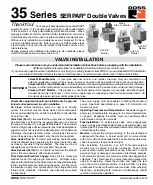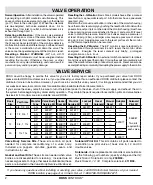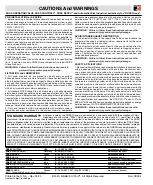
Pneumatic equipment should be maintained only by persons trained
and experienced in the maintenance of such equipment.
Supply Clean Air.
Foreign material lodging in valves is a major cause of
breakdowns. The use of an air filter located close to the valve is strongly
recommended. The filter bowl should be drained regularly, and if its location
makes draining difficult, the filter should be equipped with an automatic drain.
Check Lubricator Supply Rate.
A lubricator should put a fine oil mist into
the air line in direct proportion to the rate of air flow. Excessive lubrication can
cause puddling in the valve and lead to malfunctions. For most applications
an oil flow rate in the lubricator of one drop per minute is adequate. (Note
that the double valve itself does not require air line lubrication.)
Compatible Lubricants.
Although this valve does not require air line
lubrication, it may be used with lubricated air being supplied to other
mechanisms. Some oils contain additives that can harm seals or other valve
components and so cause the valve to malfunction. Avoid oils with phosphate
additives (e.g., zinc dithiophosphate), and diester oils; both types can harm
valve components. The best oils to use are generally petroleum base oils
with oxidation inhibitors, an aniline point between 180°F (82°C) and 220°F
(104°C), and an ISO 32 or lighter viscosity.
Some compatible oils are listed above at the right. These oils, although
believed to be compatible, could change without notice because
manufacturers sometimes reformulate their oils. Therefore, use oils
specifically compounded for air line service. If it is a synthetic oil, contact
the oil manufacturer for compatibility information.
Cleaning the Valve.
If the air supplied to the valve has not been well filtered,
the interior of the valve may accumulate dirt and varnish which can affect
the valve’s performance. This can cause sluggish or erratic valve action
and nuisance lockouts. A schedule should be established for cleaning all
valves, the frequency depending on the cleanliness of the air being supplied.
COMPATIBLE LUBRICANTS
Maker
Brand Name
Amoco ...............American Industrial Oil 32
Amoco Spindle Oil C, Amolite 32
Citgo .................Pacemaker 32
Exxon ................Spinesstic 22, Teresstic 32
Mobil ..................Velocite 10
Non-Fluid Oil .....Air Lube 10H/NR
Shell ...................Turbo T32
Sun ....................Sunvis 11, Sunvis 722
Texaco ...............Regal R&O 32
Union .................Union Turbine Oil
Construction:
Dual poppet.
Mounting Type:
Inline.
Pilot Solenoids:
Two, rated for continuous duty.
Standard Voltages:
24 volts DC; 110-120 volts AC, 50/60 Hz.
Power Consumption
(each solenoid)
:
Basic Size 4:
30 VA inrush, 16 VA holding on AC; 11 watts on DC.
Basic Size 8, 12, 30:
87 VA inrush, 30 VA holding on AC;
14 watts on DC.
Ambient Temperature:
40° to 120°F (4° to 50°C).
Media Temperature:
40° to 175°F (4° to 80°C).
Flow Media:
Filtered air.
Inlet Pressure:
Basic Size 4:
30 to 100 psig (2 to 6.9 bar).
Basic Size 8, 12, 30:
30 to 125 psig (2 to 8.5 bar).
Pilot Pressure:
Supplied internally from inlet port.
E-P MONITOR:
Reset solenoid is rated only for intermittent
duty. Energizing it continuously will lead to solenoid burnout and
nullify the reset function. Permissible voltage range is marked
on the solenoid housing.
Enclosure Rating:
IP65, IEC 60529.
Electrical Connections:
EN 175301-803 Form A, uses two
cord-grip connectors at solenoids.
...................................................................................................
L-G MONITOR:
Reset pressure requirements.
Electrical Connections:
Uses terminal strip connectors.
Basic Size 4:
At least 30 psig (2 bar).
Basic Sizes 8, 12, 30:
At least 60 psig (4 bar).
...................................................................................................
D-S MONITOR:
Use voltage and hertz as shown on D-S monitor
label. Power supply must be independent and continuous.
www.rosscontrols.com
3
VALVE MAINTENANCE
VALVE SPECIFICATIONS
IMPORTANT NOTE:
Please read carefully and thoroughly all the
WARNINGS
and
CAUTIONS
on page1 and page 4.
To clean the valve use any good commercial solvent. Do
not
scrape varnished surfaces. Also do
not
use chlorinated
solvents or abrasive materials. The former damages
seals, and abrasives can do permanent damage to metal
parts. Before reassembling the valve, lubricate all sliding
surfaces with a grease such as MobilGrease 28.
Electrical Contacts.
In the electrical circuits associated
with the valve solenoids, keep all switches or relay
contacts in good condition to avoid solenoid malfunctions.
Replace Worn Components.
In most cases it is not
necessary to remove the valve from its installation for
servicing. However, turn off the electrical power to the
valve, shut off the air supply, and exhaust the air in the
system before beginning any disassembly operation.
Service kits are listed on page 2.
You may also request a free service manual from ROSS
in the U.S.A. at 1-800-GET-ROSS.
Electrical Connector
Form
Electrical Connector Type
Cord Length
meter (feet)
Cord
Diameter
Electrical Connector Model Number
Without
Light
Lighted Connector
24 Volts DC
120 Volts AC
EN 175301-803
Form A
Prewired Connector (18 gauge)
2 (61/2)
6-mm
721K77
720K77-W
720K77-Z
Prewired Connector (18 gauge)
2 (61/2)
10-mm
371K77
383K77-W
383K77-Z
Connector for threaded conduit
(1/2 inch electrical conduit fittings)
–
–
723K77
724K77-W
724K77-Z
Connector Only
–
–
937K87
936K87-W
936K87-Z
CAUTIONS: Do not use electrical connectors with surge suppressors, as this may increase valve response time when de-actuating the solenoids.






















